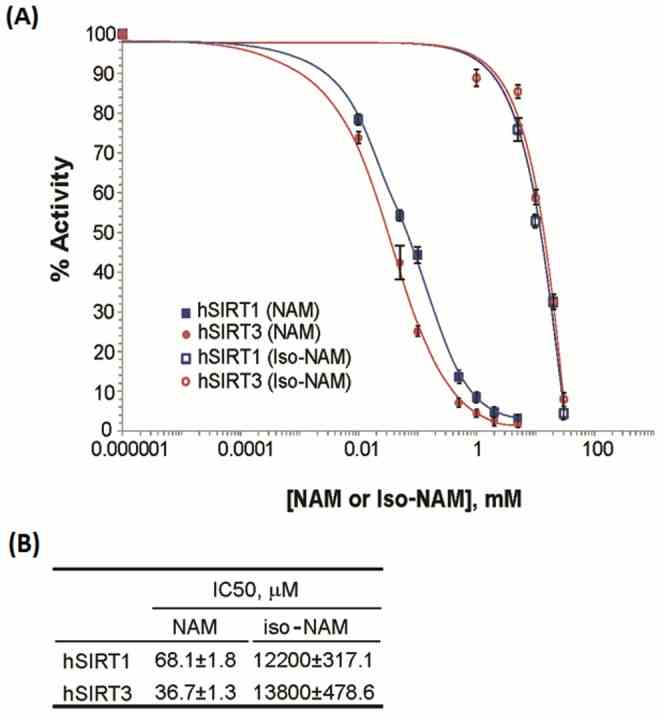Active Recombinant Human SIRT3
| Cat.No. : | SIRT3-341H |
- Specification
- Gene Information
- Related Products
- Citation
- Download
| Species : | Human |
| Source : | E.coli |
| Tag : | Non |
| Description : | Sirtuins are pylogenetically conserved from bacteria to humans and regulate cell functions beyond silencing. The proteins show a relevance to cancer, obesity, muscle differentiation, inflammation and neuro-degeneration. In addition, Sirtuin activity may extend the lifespan of several organisms. Human Sirtuin 3 (Sirt3) is a mitochondrial member of Class III of the protein deacetylases family (historically called histone deacetylases family). Class III deacetylases utilize NAD+ as cosubstrate and act either as deacetylases or as ADP-ribosyltransferases. Sirt3 regulates mitochondrial function and thermogenesis; the enzyme can deacetylate and thereby activate the mitochondrial acetyl-CoA synthetase 2 which enables mitochondria to activate acetate for metabolic reactions. MW=32.2kDa (292 amino acids). |
| Form : | Purified recombinant protein in 20mM Tris-HCl pH7.8, and 150mM NaCl. |
| Activity : | >20units/μg 1 unit is defined as that amount of enzyme required to catalyze 1 pmol of product per minute at 37℃, 100μM Fluor de Lys-SIRT2 Substrate (Biomol) and 500μM NAD+. |
| Purity : | >90% by SDS-PAGE. |
| Usage : | For in vitro use only. |
| Storage : | Quality guaranteed for 12 months, store at -80℃. Avoid freeze / thaw cycles. |
| Publications : |
Mechanism of Inhibition of the Human Sirtuin Enzyme SIRT3 by Nicotinamide: Computational and Experimental Studies (2014)
|
| Gene Name | SIRT3 sirtuin (silent mating type information regulation 2 homolog) 3 (S. cerevisiae) [ Homo sapiens ] |
| Synonyms | SIRT3; sirtuin (silent mating type information regulation 2 homolog) 3 (S. cerevisiae); SIR2L3; NAD-dependent deacetylase sirtuin-3, mitochondrial; EC 3.5.1.-; SIR2-like protein 3; hSIRT3; mitochondrial nicotinamide adenine dinucleotide-dependent deacetylase 2; silent mating type information regulation 2, S.cerevisiae, homolog 3; sir2-like 3; sirtuin (silent mating type information regulation 2, S.cerevisiae, homolog) 3; sirtuin 3; sirtuin type 3 |
| Gene ID | 23410 |
| mRNA Refseq | NM_001017524 |
| Protein Refseq | NP_001017524 |
| MIM | 604481 |
| UniProt ID | Q9NTG7 |
| Chromosome Location | 11p15.5 |
| Function | NAD binding; NAD+ ADP-ribosyltransferase activity; hydrolase activity; hydrolase activity, acting on carbon-nitrogen (but not peptide) bonds, in linear amides; metal ion binding; protein binding; zinc ion binding |
| ◆ Recombinant Proteins | ||
| SIRT3-4877H | Active Recombinant Human Sirtuin 3, GST-tagged | +Inquiry |
| SIRT3-28H | Recombinant Human SIRT3 Protein, His-tagged | +Inquiry |
| SIRT3-0720H | Recombinant Human SIRT3 Protein (S118-K399), His/SUMO tagged | +Inquiry |
| SIRT3-341H | Active Recombinant Human SIRT3 | +Inquiry |
| SIRT3-2681H | Recombinant Human SIRT3 protein, GST-tagged | +Inquiry |
| ◆ Cell & Tissue Lysates | ||
| SIRT3-1832HCL | Recombinant Human SIRT3 293 Cell Lysate | +Inquiry |
| SIRT3-1833HCL | Recombinant Human SIRT3 293 Cell Lysate | +Inquiry |
Mechanism of Inhibition of the Human Sirtuin Enzyme SIRT3 by Nicotinamide: Computational and Experimental Studies
Journal: PLoS ONE PubMed ID: 25221980 Data: 2022/11/28
Authors: Xiangying Guan, Ping Lin, Pratul K. Agarwal
Article Snippet:The acetylated substrate peptide based on the sequence of Acetyl-coenzyme A synthetase 2 (AceCS2 638–649, H2N-TRSGK (Ac)VMRRLLR-OH) was synthesized at PEPTIDE 2.0 Inc(Chantilly, VA, USA).The acetylated substrate peptide based on the sequence of Acetyl-coenzyme A synthetase 2 (AceCS2 638–649, H2N-TRSGK (Ac)VMRRLLR-OH) was synthesized at PEPTIDE 2.0 Inc(Chantilly, VA, USA).. Human recombinant SIRT3 was purchased from Creative BioMart(Shirley, NY, USA).. Enzyme concentrations were determined using the method of Bradford with bovine serum albumin (BSA) as the standard.Enzyme concentrations were determined using the method of Bradford with bovine serum albumin (BSA) as the standard.

( A ) Nicotinamide/isonicotinamide inhibition assays showing percent change in deacetylation activity as a function of NAM/isoNAM concentration. Data for the SIRT1 enzyme are indicated with blue squares (filled as NAM, and no filled as isoNAM); data for the

Model parameter estimates from global nonlinear fitting of mixed inhibition models for
![( A ) Recombinant human SIRT1 was incubated for 0, 10, 20, 30, 60, 120, 180, and 240 min at 37°C in the presence of 50, 125, 750, 1500 μM NAD + and 0, 50, and 100 μM NAM. ( B ) Recombinant human SIRT3 was incubated for 0, 10, 20, 30, 60, 120, 180, and 240 min at 37°C in the presence of 100, 375, 750, 1500, 3000 μM NAD + and 0, 25, 100, and 200 μM NAM. Reactions were terminated by the addition of developer and samples were analyzed by fluorometry (excitation set at 355 nm and emission at 460 nm). Data are globally nonlinear fitted to base exchange inhibition model and shown as a double-reciprocal plot of 1/ v versus 1/[ NAD + ]. In ( C ) and ( D ), the intersection points of the double reciprocal plots are enlarged for SIRT1 and SIRT3, respectively.](productimages/extendimages/pmc04164625__pone.0107729.g002.jpg)
( A ) Recombinant human SIRT1 was incubated for 0, 10, 20, 30, 60, 120, 180, and 240 min at 37°C in the presence of 50, 125, 750, 1500 μM NAD + and 0, 50, and 100 μM NAM. ( B ) Recombinant human
Not For Human Consumption!
Inquiry
- Reviews (0)
- Q&As (0)
Ask a Question for All SIRT3 Products
Required fields are marked with *
My Review for All SIRT3 Products
Required fields are marked with *



